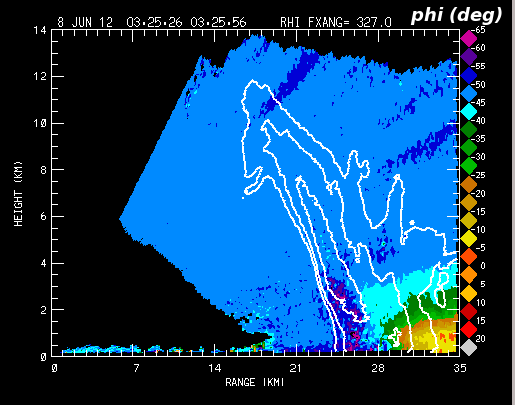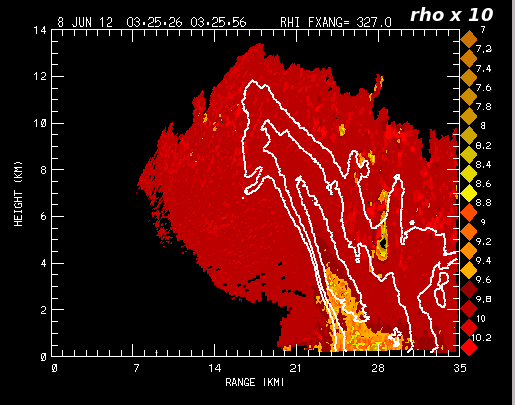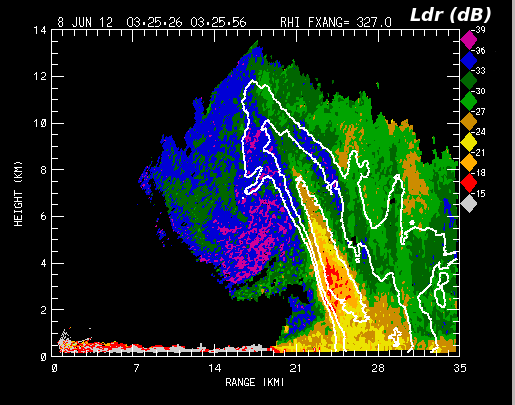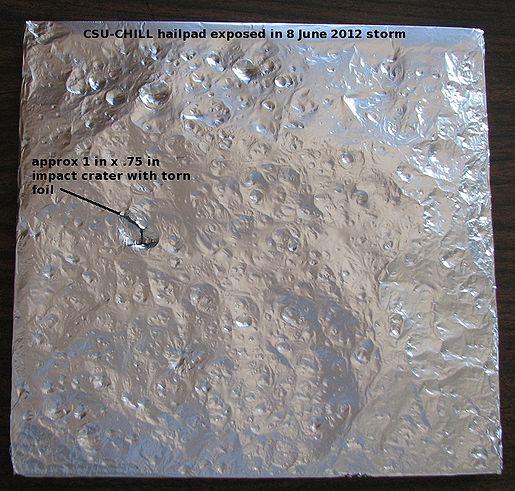Selected dual polarization observations in a supercell thunderstorm: 8 June 2012: Difference between revisions
Pat kennedy (talk | contribs) No edit summary |
Pat kennedy (talk | contribs) No edit summary |
||
| Line 11: | Line 11: | ||
==Introduction== | ==Introduction== | ||
During operations for the DC3 field project on 7 June, 2012 (local date), a supercell thunderstorm developed in the western dual Doppler lobe formed by the CSU-CHILL and Pawnee radars. In synchronization with the Pawnee radar, CSU-CHILL began a volume scan at 0324 UTC on the 8th. This volume was interrupted after 4 sweeps to execute a series of RHI sweeps through the approaching storm. The following plot shows the dual Doppler-derived horizontal wind field at 2.75 km MSL based on the 0324 UTC volume data. (The NCAR SPRINT program was used to interpolate the data from the individual radars to a common Cartesian grid; the synthesis of the horizontal wind field components was done using CEDRIC.) Since the CHILL did not execute a full volume scan, the color-filled reflectivity field was generated from the Pawnee radar data. The low level maximized in the vicinity of the reflectivity "notch" adjacent to | During operations for the DC3 field project on 7 June, 2012 (local date), a supercell thunderstorm developed in the western dual Doppler lobe formed by the CSU-CHILL and Pawnee radars. In synchronization with the Pawnee radar, CSU-CHILL began a volume scan at 0324 UTC on the 8th. This volume was interrupted after 4 sweeps to execute a series of RHI sweeps through the approaching storm. The following plot shows the dual Doppler-derived horizontal wind field at 2.75 km MSL based on the 0324 UTC volume data. (The NCAR SPRINT program was used to interpolate the data from the individual radars to a common Cartesian grid; the synthesis of the horizontal wind field components was done using CEDRIC.) Much of the reflectivity core was located within the radar baseline area, small radar beam intersection angles stopped the wind synthesis in this area. Since the CHILL did not execute a full volume scan, the color-filled reflectivity field was generated from the Pawnee radar data. The low level inflow maximized in the vicinity of the reflectivity "notch" adjacent to a dissipating mesocyclone circulation. | ||
[[Image:0325 2.75km DDOP anot.png|center]] | [[Image:0325 2.75km DDOP anot.png|center]] | ||
==327 degree azimuth RHI data== | |||
At 0325:26 CSU-CHILL performed an RHI scan through the inflow notch and the neighboring high reflectivity core. The following series of plots present selected aspects of the data collected in this RHI sweep. | |||
At ranges less than 21 km, the reflectivity pattern included the forward overhanging configuration associated with strong updrafts. | |||
[[Image:RHI DZ anot.png|center]] | [[Image:RHI DZ anot.png|center]] | ||
The radial velocity data showed a well-organized inflow pattern near the surface. Velocities maximized in the forward anvil where the combination of the environmental ambient winds and diverging outflow from the summit of the updraft combined to generate radial velocities in excess of 50 mps towards the radar (negative sign). | |||
[[Image:RHI VU anot.png|center]] | [[Image:RHI VU anot.png|center]] | ||
The updraft was probably strong enough to cause drop size sorting in the inflow area around 21 km range. Since only relatively large, oblate drops would have a high enough terminal velocity to descend into this area, differential reflectivity (Zdr) values were quite positive at low altitudes in the inflow area. (The ingestion of insects flying in the boundary layer was probably also contributing to the positive Zdr regime.) Within the leading edge of the strong precipitation shaft, Zdr's quickly decreased as the radar pulse volume sampled an increasing fraction of quasi-spherical hailstones vs. the oblate raindrops in the inflow. The slightly negative Zdr values near the 24 km range suggest that some of the hail / graupel particles may have had their major axes oriented vertically. The slightly negative Zdr "shadow" located down-range of the reflectivity core suggests that differential attenuation was preferentially attenuating the horizontally-polarized signal relative to the vertically-polarized signal, especially in the vicinity of the melting level. | |||
[[Image:RHI Zdr anot.png|center]] | [[Image:RHI Zdr anot.png|center]] | ||
The differential propagation phase initially shifted in an upward direction along the color scale (i.e., towards dark blue and purple as the precipitation shaft is entered near 24 km range. This reversed color progression is consistent with the vertical ice particle orientations that were implied by the negative Zdr's in this same region. Additional areas of up-scale color progression were apparent in the anvil region where electric field intensities strong enough to rotate the ice crystals towards a vertical orientation likely existed. | |||
[[Image:RHI DP anot.png|center]] | [[Image:RHI DP anot.png|center]] | ||
Revision as of 16:51, 30 January 2013
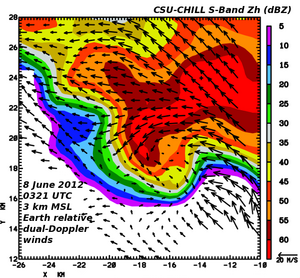
Horizontal wind field synthesized from coordinated CSU-CHILL and Pawnee radar volume scans done during the NSF-sponsored DC3 project. Plots of the dual-polarization data collected ~5 minutes later in an RHI scan through the low level inflow and hail core areas have been assembled.
Introduction
During operations for the DC3 field project on 7 June, 2012 (local date), a supercell thunderstorm developed in the western dual Doppler lobe formed by the CSU-CHILL and Pawnee radars. In synchronization with the Pawnee radar, CSU-CHILL began a volume scan at 0324 UTC on the 8th. This volume was interrupted after 4 sweeps to execute a series of RHI sweeps through the approaching storm. The following plot shows the dual Doppler-derived horizontal wind field at 2.75 km MSL based on the 0324 UTC volume data. (The NCAR SPRINT program was used to interpolate the data from the individual radars to a common Cartesian grid; the synthesis of the horizontal wind field components was done using CEDRIC.) Much of the reflectivity core was located within the radar baseline area, small radar beam intersection angles stopped the wind synthesis in this area. Since the CHILL did not execute a full volume scan, the color-filled reflectivity field was generated from the Pawnee radar data. The low level inflow maximized in the vicinity of the reflectivity "notch" adjacent to a dissipating mesocyclone circulation.

327 degree azimuth RHI data
At 0325:26 CSU-CHILL performed an RHI scan through the inflow notch and the neighboring high reflectivity core. The following series of plots present selected aspects of the data collected in this RHI sweep.
At ranges less than 21 km, the reflectivity pattern included the forward overhanging configuration associated with strong updrafts.
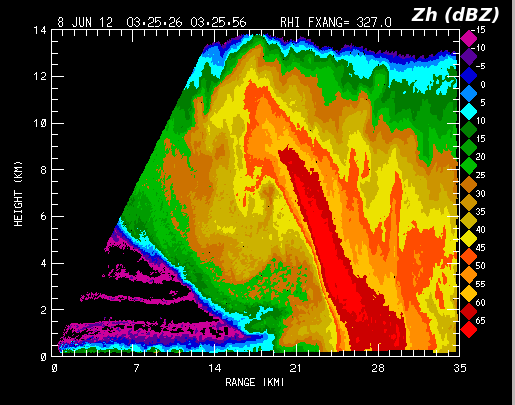
The radial velocity data showed a well-organized inflow pattern near the surface. Velocities maximized in the forward anvil where the combination of the environmental ambient winds and diverging outflow from the summit of the updraft combined to generate radial velocities in excess of 50 mps towards the radar (negative sign).
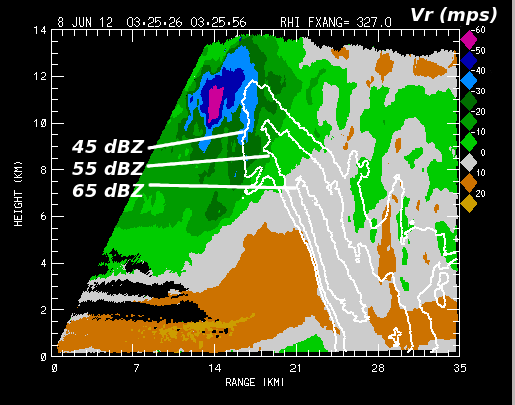
The updraft was probably strong enough to cause drop size sorting in the inflow area around 21 km range. Since only relatively large, oblate drops would have a high enough terminal velocity to descend into this area, differential reflectivity (Zdr) values were quite positive at low altitudes in the inflow area. (The ingestion of insects flying in the boundary layer was probably also contributing to the positive Zdr regime.) Within the leading edge of the strong precipitation shaft, Zdr's quickly decreased as the radar pulse volume sampled an increasing fraction of quasi-spherical hailstones vs. the oblate raindrops in the inflow. The slightly negative Zdr values near the 24 km range suggest that some of the hail / graupel particles may have had their major axes oriented vertically. The slightly negative Zdr "shadow" located down-range of the reflectivity core suggests that differential attenuation was preferentially attenuating the horizontally-polarized signal relative to the vertically-polarized signal, especially in the vicinity of the melting level.
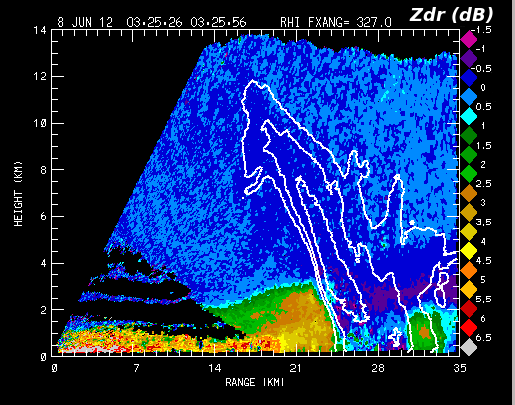
The differential propagation phase initially shifted in an upward direction along the color scale (i.e., towards dark blue and purple as the precipitation shaft is entered near 24 km range. This reversed color progression is consistent with the vertical ice particle orientations that were implied by the negative Zdr's in this same region. Additional areas of up-scale color progression were apparent in the anvil region where electric field intensities strong enough to rotate the ice crystals towards a vertical orientation likely existed.
